An investigation into layout features of English texts introducing world cultural heritage sites in the United Kingdom
Layout with its characteristics and functions has attracted
much attention of many language researchers. In a text in general
and a text introducing World Cultural Heritage Sites in particular, the
layout plays an important role in arranging ideas as well as sections.
Based on 26 English Texts Introducing World Cultural Heritage Sites
in the UK on the official website of UNESCO
with the descriptive method as the dominant one, this article identifies
and analyzes the layout features of English Texts Introducing World
Cultural Heritage Sites (ETWHS) in the UK in order to discover the
patterns and components of the ETWHS. It is hoped that the findings
of this research can provide Vietnamese learners of English and
copywriters with an insight into the discourse features of the abovementioned texts
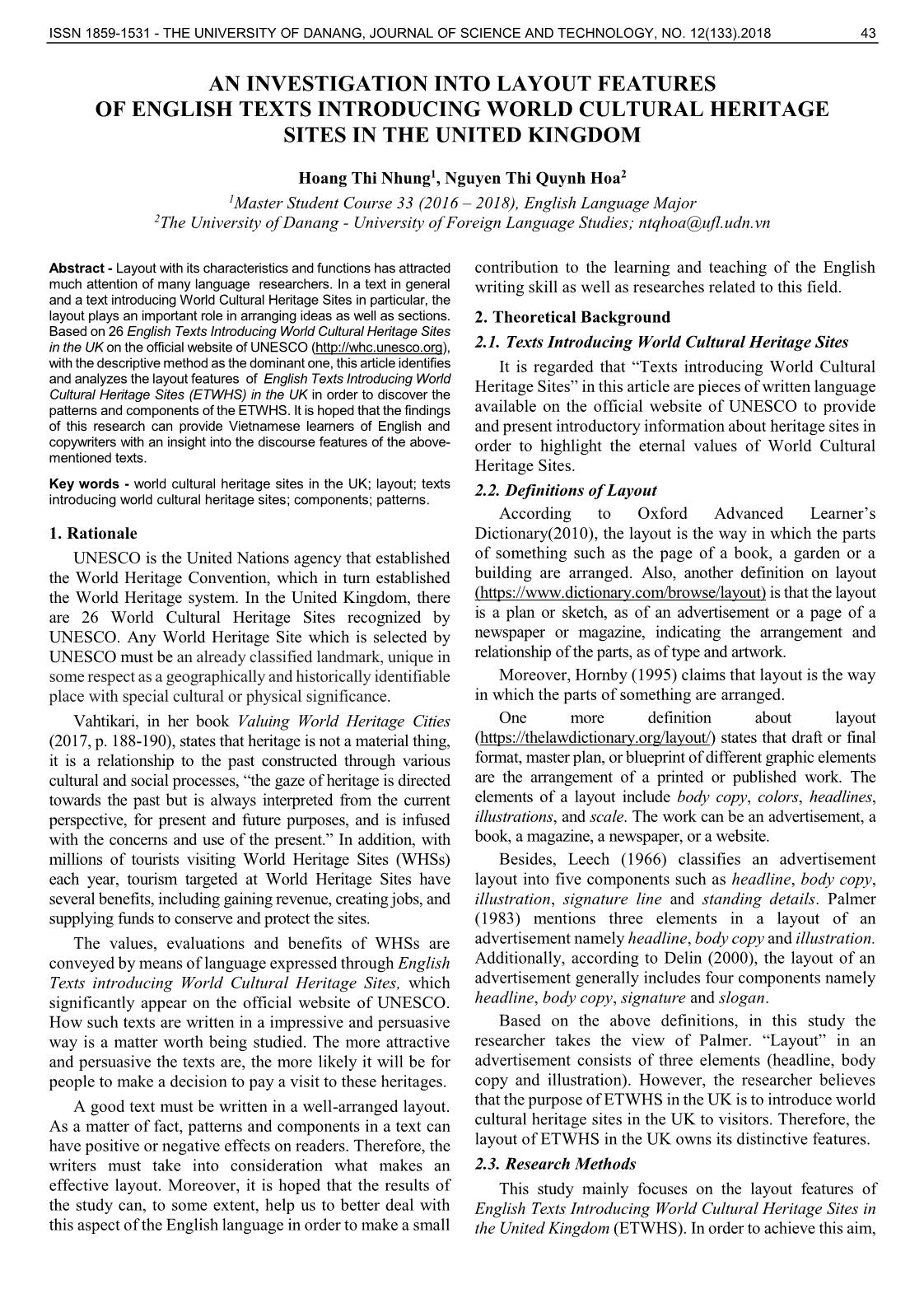
Trang 1
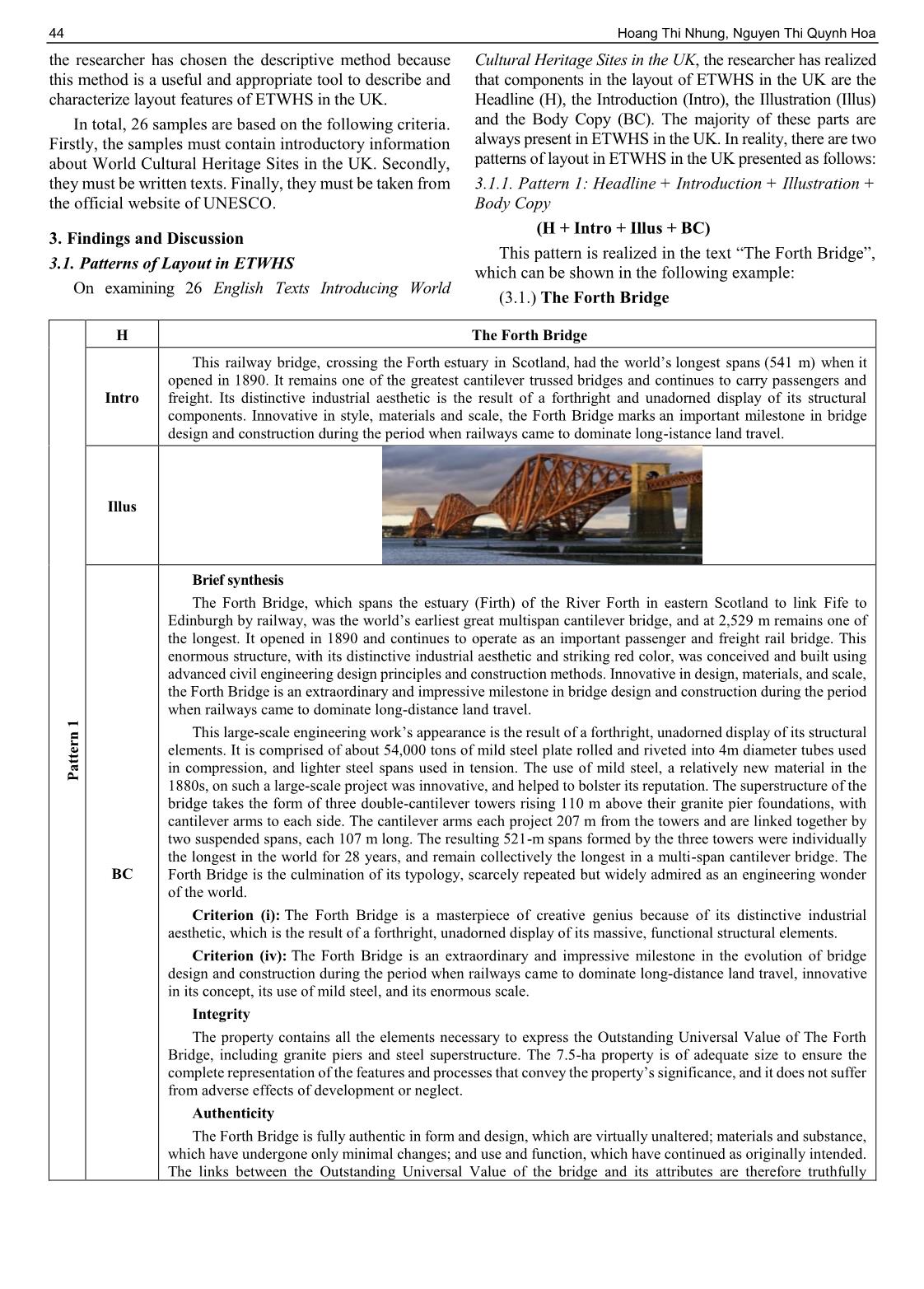
Trang 2
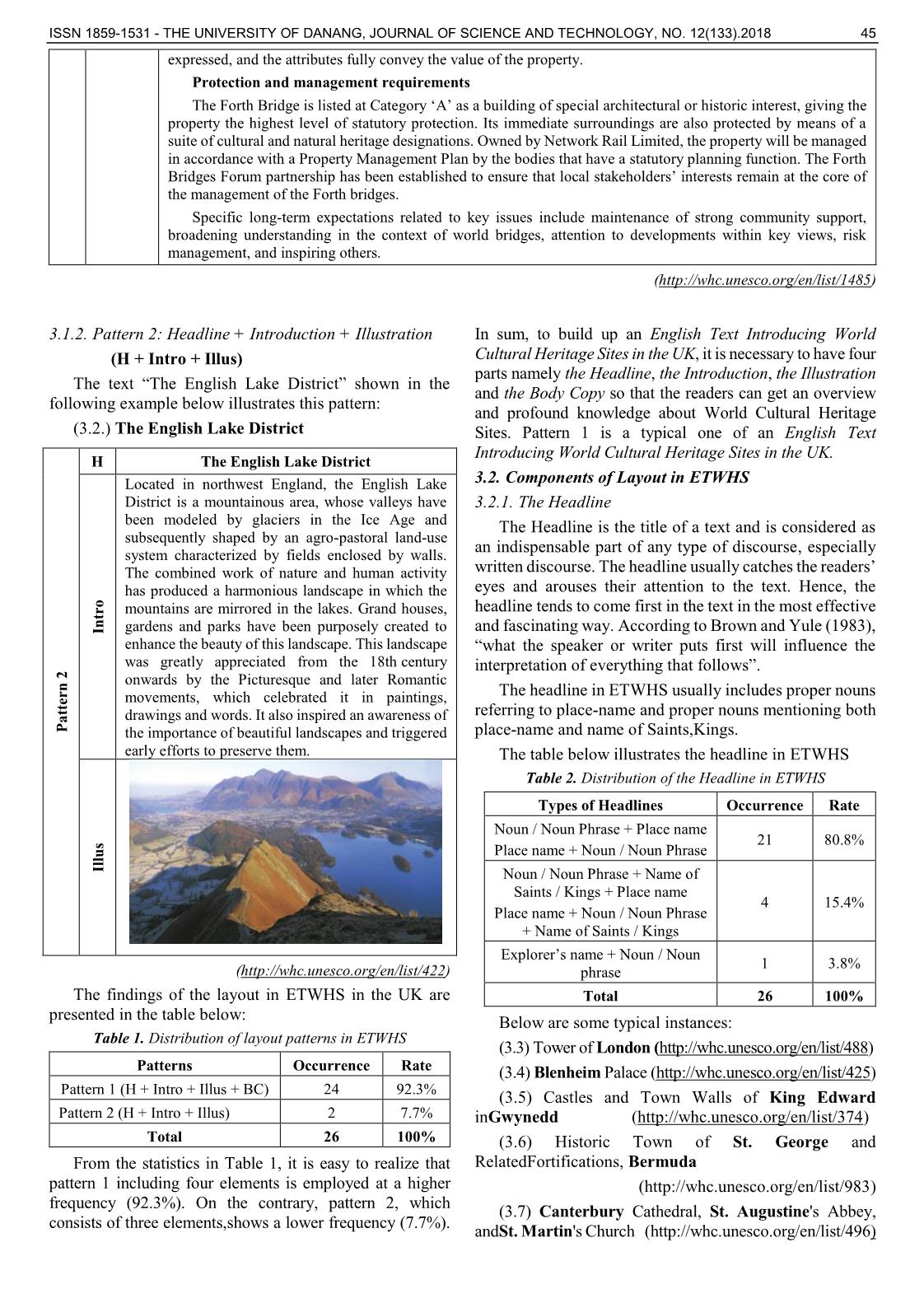
Trang 3
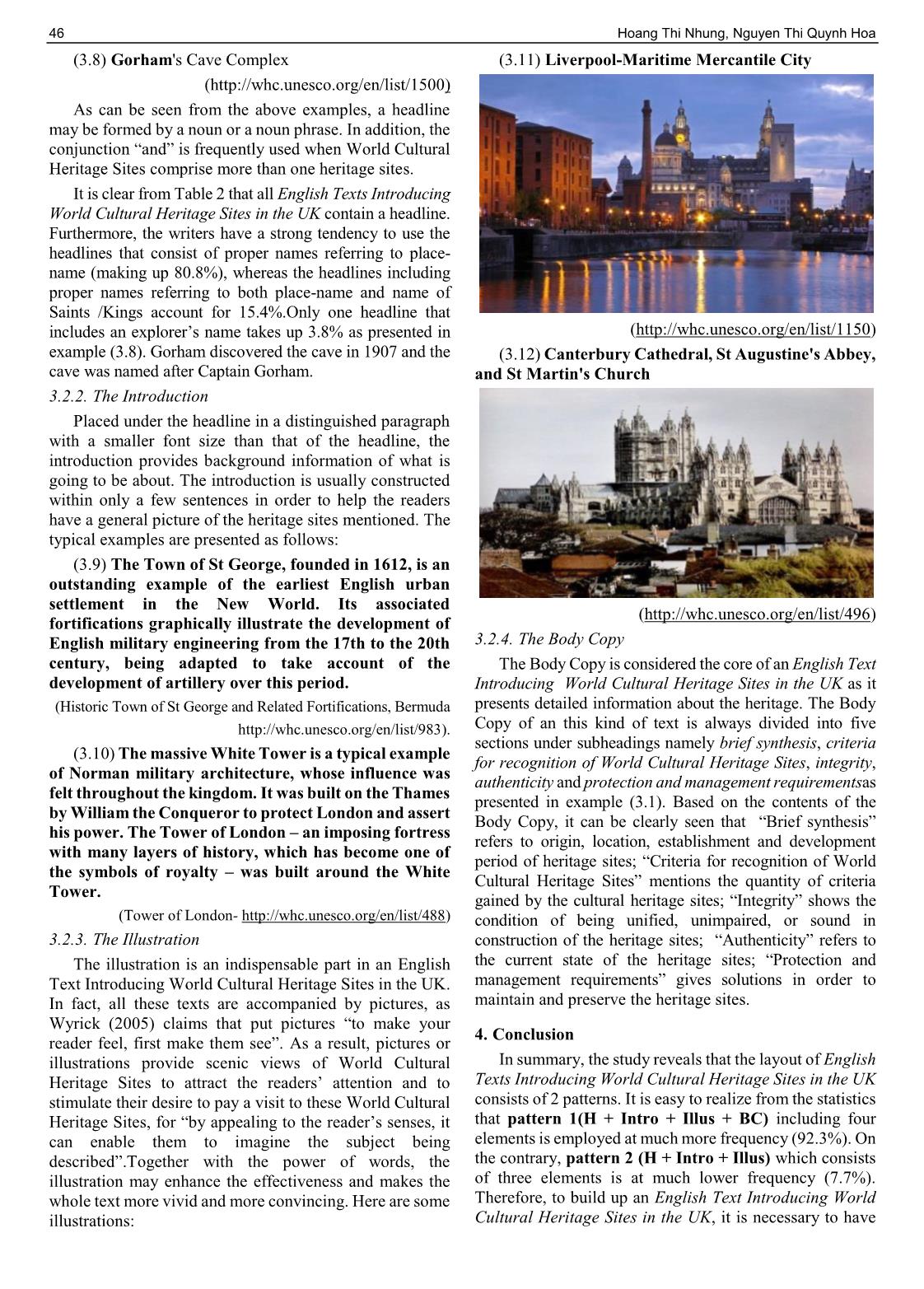
Trang 4
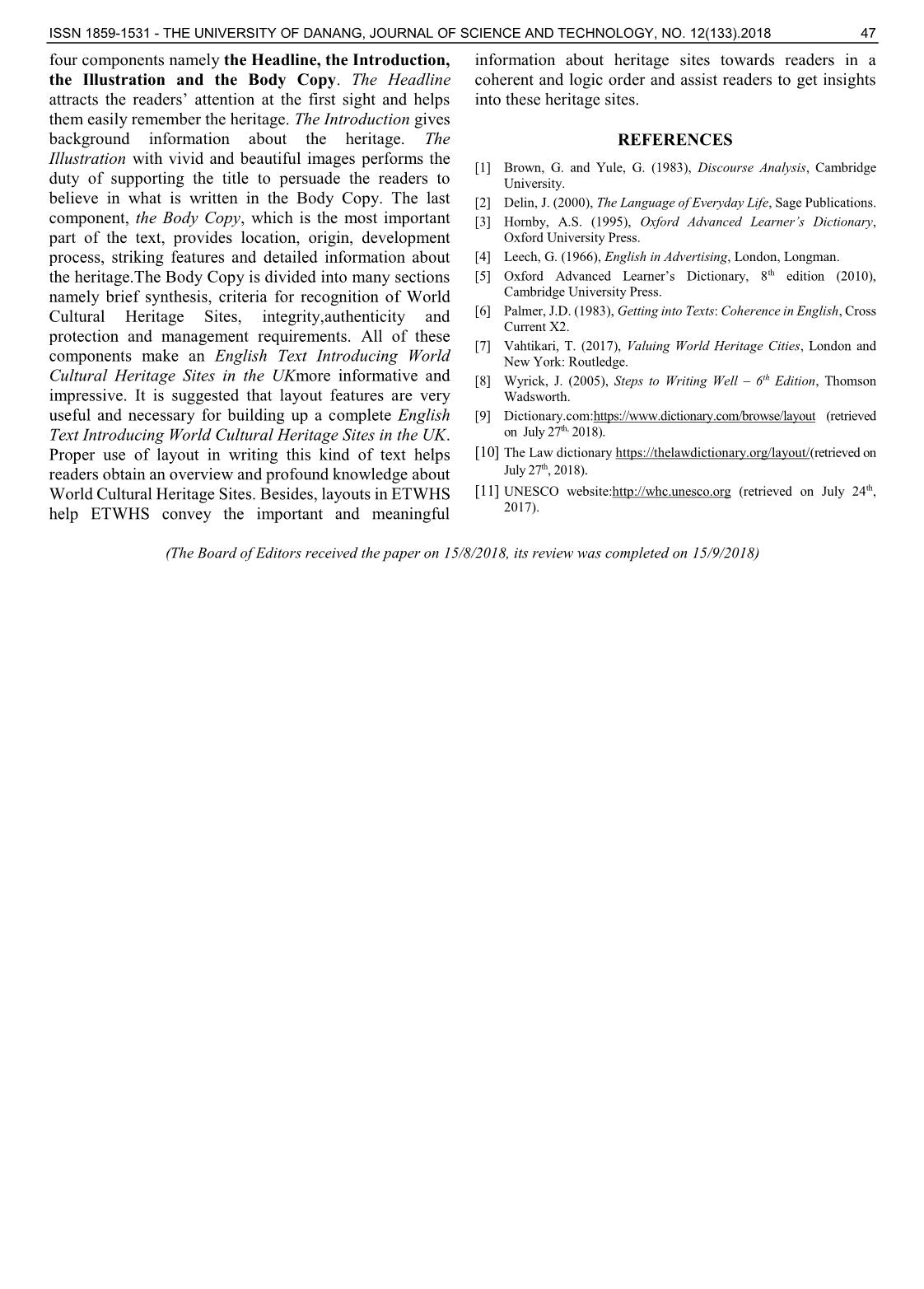
Trang 5
Tóm tắt nội dung tài liệu: An investigation into layout features of English texts introducing world cultural heritage sites in the United Kingdom

od when railways came to dominate long-istance land travel. Illus BC Brief synthesis The Forth Bridge, which spans the estuary (Firth) of the River Forth in eastern Scotland to link Fife to Edinburgh by railway, was the world’s earliest great multispan cantilever bridge, and at 2,529 m remains one of the longest. It opened in 1890 and continues to operate as an important passenger and freight rail bridge. This enormous structure, with its distinctive industrial aesthetic and striking red color, was conceived and built using advanced civil engineering design principles and construction methods. Innovative in design, materials, and scale, the Forth Bridge is an extraordinary and impressive milestone in bridge design and construction during the period when railways came to dominate long-distance land travel. This large-scale engineering work’s appearance is the result of a forthright, unadorned display of its structural elements. It is comprised of about 54,000 tons of mild steel plate rolled and riveted into 4m diameter tubes used in compression, and lighter steel spans used in tension. The use of mild steel, a relatively new material in the 1880s, on such a large-scale project was innovative, and helped to bolster its reputation. The superstructure of the bridge takes the form of three double-cantilever towers rising 110 m above their granite pier foundations, with cantilever arms to each side. The cantilever arms each project 207 m from the towers and are linked together by two suspended spans, each 107 m long. The resulting 521-m spans formed by the three towers were individually the longest in the world for 28 years, and remain collectively the longest in a multi-span cantilever bridge. The Forth Bridge is the culmination of its typology, scarcely repeated but widely admired as an engineering wonder of the world. Criterion (i): The Forth Bridge is a masterpiece of creative genius because of its distinctive industrial aesthetic, which is the result of a forthright, unadorned display of its massive, functional structural elements. Criterion (iv): The Forth Bridge is an extraordinary and impressive milestone in the evolution of bridge design and construction during the period when railways came to dominate long-distance land travel, innovative in its concept, its use of mild steel, and its enormous scale. Integrity The property contains all the elements necessary to express the Outstanding Universal Value of The Forth Bridge, including granite piers and steel superstructure. The 7.5-ha property is of adequate size to ensure the complete representation of the features and processes that convey the property’s significance, and it does not suffer from adverse effects of development or neglect. Authenticity The Forth Bridge is fully authentic in form and design, which are virtually unaltered; materials and substance, which have undergone only minimal changes; and use and function, which have continued as originally intended. The links between the Outstanding Universal Value of the bridge and its attributes are therefore truthfully ISSN 1859-1531 - THE UNIVERSITY OF DANANG, JOURNAL OF SCIENCE AND TECHNOLOGY, NO. 12(133).2018 45 expressed, and the attributes fully convey the value of the property. Protection and management requirements The Forth Bridge is listed at Category ‘A’ as a building of special architectural or historic interest, giving the property the highest level of statutory protection. Its immediate surroundings are also protected by means of a suite of cultural and natural heritage designations. Owned by Network Rail Limited, the property will be managed in accordance with a Property Management Plan by the bodies that have a statutory planning function. The Forth Bridges Forum partnership has been established to ensure that local stakeholders’ interests remain at the core of the management of the Forth bridges. Specific long-term expectations related to key issues include maintenance of strong community support, broadening understanding in the context of world bridges, attention to developments within key views, risk management, and inspiring others. ( 3.1.2. Pattern 2: Headline + Introduction + Illustration (H + Intro + Illus) The text “The English Lake District” shown in the following example below illustrates this pattern: (3.2.) The English Lake District P a tt er n 2 H The English Lake District In tr o Located in northwest England, the English Lake District is a mountainous area, whose valleys have been modeled by glaciers in the Ice Age and subsequently shaped by an agro-pastoral land-use system characterized by fields enclosed by walls. The combined work of nature and human activity has produced a harmonious landscape in which the mountains are mirrored in the lakes. Grand houses, gardens and parks have been purposely created to enhance the beauty of this landscape. This landscape was greatly appreciated from the 18th century onwards by the Picturesque and later Romantic movements, which celebrated it in paintings, drawings and words. It also inspired an awareness of the importance of beautiful landscapes and triggered early efforts to preserve them. Il lu s ( The findings of the layout in ETWHS in the UK are presented in the table below: Table 1. Distribution of layout patterns in ETWHS Patterns Occurrence Rate Pattern 1 (H + Intro + Illus + BC) 24 92.3% Pattern 2 (H + Intro + Illus) 2 7.7% Total 26 100% From the statistics in Table 1, it is easy to realize that pattern 1 including four elements is employed at a higher frequency (92.3%). On the contrary, pattern 2, which consists of three elements,shows a lower frequency (7.7%). In sum, to build up an English Text Introducing World Cultural Heritage Sites in the UK, it is necessary to have four parts namely the Headline, the Introduction, the Illustration and the Body Copy so that the readers can get an overview and profound knowledge about World Cultural Heritage Sites. Pattern 1 is a typical one of an English Text Introducing World Cultural Heritage Sites in the UK. 3.2. Components of Layout in ETWHS 3.2.1. The Headline The Headline is the title of a text and is considered as an indispensable part of any type of discourse, especially written discourse. The headline usually catches the readers’ eyes and arouses their attention to the text. Hence, the headline tends to come first in the text in the most effective and fascinating way. According to Brown and Yule (1983), “what the speaker or writer puts first will influence the interpretation of everything that follows”. The headline in ETWHS usually includes proper nouns referring to place-name and proper nouns mentioning both place-name and name of Saints,Kings. The table below illustrates the headline in ETWHS Table 2. Distribution of the Headline in ETWHS Types of Headlines Occurrence Rate Noun / Noun Phrase + Place name Place name + Noun / Noun Phrase 21 80.8% Noun / Noun Phrase + Name of Saints / Kings + Place name Place name + Noun / Noun Phrase + Name of Saints / Kings 4 15.4% Explorer’s name + Noun / Noun phrase 1 3.8% Total 26 100% Below are some typical instances: (3.3) Tower of London ( (3.4) Blenheim Palace ( (3.5) Castles and Town Walls of King Edward inGwynedd ( (3.6) Historic Town of St. George and RelatedFortifications, Bermuda ( (3.7) Canterbury Cathedral, St. Augustine's Abbey, andSt. Martin's Church ( 46 Hoang Thi Nhung, Nguyen Thi Quynh Hoa (3.8) Gorham's Cave Complex ( As can be seen from the above examples, a headline may be formed by a noun or a noun phrase. In addition, the conjunction “and” is frequently used when World Cultural Heritage Sites comprise more than one heritage sites. It is clear from Table 2 that all English Texts Introducing World Cultural Heritage Sites in the UK contain a headline. Furthermore, the writers have a strong tendency to use the headlines that consist of proper names referring to place- name (making up 80.8%), whereas the headlines including proper names referring to both place-name and name of Saints /Kings account for 15.4%.Only one headline that includes an explorer’s name takes up 3.8% as presented in example (3.8). Gorham discovered the cave in 1907 and the cave was named after Captain Gorham. 3.2.2. The Introduction Placed under the headline in a distinguished paragraph with a smaller font size than that of the headline, the introduction provides background information of what is going to be about. The introduction is usually constructed within only a few sentences in order to help the readers have a general picture of the heritage sites mentioned. The typical examples are presented as follows: (3.9) The Town of St George, founded in 1612, is an outstanding example of the earliest English urban settlement in the New World. Its associated fortifications graphically illustrate the development of English military engineering from the 17th to the 20th century, being adapted to take account of the development of artillery over this period. (Historic Town of St George and Related Fortifications, Bermuda (3.10) The massive White Tower is a typical example of Norman military architecture, whose influence was felt throughout the kingdom. It was built on the Thames by William the Conqueror to protect London and assert his power. The Tower of London – an imposing fortress with many layers of history, which has become one of the symbols of royalty – was built around the White Tower. (Tower of London- 3.2.3. The Illustration The illustration is an indispensable part in an English Text Introducing World Cultural Heritage Sites in the UK. In fact, all these texts are accompanied by pictures, as Wyrick (2005) claims that put pictures “to make your reader feel, first make them see”. As a result, pictures or illustrations provide scenic views of World Cultural Heritage Sites to attract the readers’ attention and to stimulate their desire to pay a visit to these World Cultural Heritage Sites, for “by appealing to the reader’s senses, it can enable them to imagine the subject being described”.Together with the power of words, the illustration may enhance the effectiveness and makes the whole text more vivid and more convincing. Here are some illustrations: (3.11) Liverpool-Maritime Mercantile City ( (3.12) Canterbury Cathedral, St Augustine's Abbey, and St Martin's Church ( 3.2.4. The Body Copy The Body Copy is considered the core of an English Text Introducing World Cultural Heritage Sites in the UK as it presents detailed information about the heritage. The Body Copy of an this kind of text is always divided into five sections under subheadings namely brief synthesis, criteria for recognition of World Cultural Heritage Sites, integrity, authenticity and protection and management requirementsas presented in example (3.1). Based on the contents of the Body Copy, it can be clearly seen that “Brief synthesis” refers to origin, location, establishment and development period of heritage sites; “Criteria for recognition of World Cultural Heritage Sites” mentions the quantity of criteria gained by the cultural heritage sites; “Integrity” shows the condition of being unified, unimpaired, or sound in construction of the heritage sites; “Authenticity” refers to the current state of the heritage sites; “Protection and management requirements” gives solutions in order to maintain and preserve the heritage sites. 4. Conclusion In summary, the study reveals that the layout of English Texts Introducing World Cultural Heritage Sites in the UK consists of 2 patterns. It is easy to realize from the statistics that pattern 1(H + Intro + Illus + BC) including four elements is employed at much more frequency (92.3%). On the contrary, pattern 2 (H + Intro + Illus) which consists of three elements is at much lower frequency (7.7%). Therefore, to build up an English Text Introducing World Cultural Heritage Sites in the UK, it is necessary to have ISSN 1859-1531 - THE UNIVERSITY OF DANANG, JOURNAL OF SCIENCE AND TECHNOLOGY, NO. 12(133).2018 47 four components namely the Headline, the Introduction, the Illustration and the Body Copy. The Headline attracts the readers’ attention at the first sight and helps them easily remember the heritage. The Introduction gives background information about the heritage. The Illustration with vivid and beautiful images performs the duty of supporting the title to persuade the readers to believe in what is written in the Body Copy. The last component, the Body Copy, which is the most important part of the text, provides location, origin, development process, striking features and detailed information about the heritage.The Body Copy is divided into many sections namely brief synthesis, criteria for recognition of World Cultural Heritage Sites, integrity,authenticity and protection and management requirements. All of these components make an English Text Introducing World Cultural Heritage Sites in the UKmore informative and impressive. It is suggested that layout features are very useful and necessary for building up a complete English Text Introducing World Cultural Heritage Sites in the UK. Proper use of layout in writing this kind of text helps readers obtain an overview and profound knowledge about World Cultural Heritage Sites. Besides, layouts in ETWHS help ETWHS convey the important and meaningful information about heritage sites towards readers in a coherent and logic order and assist readers to get insights into these heritage sites. REFERENCES [1] Brown, G. and Yule, G. (1983), Discourse Analysis, Cambridge University. [2] Delin, J. (2000), The Language of Everyday Life, Sage Publications. [3] Hornby, A.S. (1995), Oxford Advanced Learner’s Dictionary, Oxford University Press. [4] Leech, G. (1966), English in Advertising, London, Longman. [5] Oxford Advanced Learner’s Dictionary, 8th edition (2010), Cambridge University Press. [6] Palmer, J.D. (1983), Getting into Texts: Coherence in English, Cross Current X2. [7] Vahtikari, T. (2017), Valuing World Heritage Cities, London and New York: Routledge. [8] Wyrick, J. (2005), Steps to Writing Well – 6th Edition, Thomson Wadsworth. [9] Dictionary.com:https://www.dictionary.com/browse/layout (retrieved on July 27th, 2018). [10] The Law dictionary https://thelawdictionary.org/layout/(retrieved on July 27th, 2018). [11] UNESCO website: (retrieved on July 24th, 2017). (The Board of Editors received the paper on 15/8/2018, its review was completed on 15/9/2018)
File đính kèm:
 an_investigation_into_layout_features_of_english_texts_intro.pdf
an_investigation_into_layout_features_of_english_texts_intro.pdf

